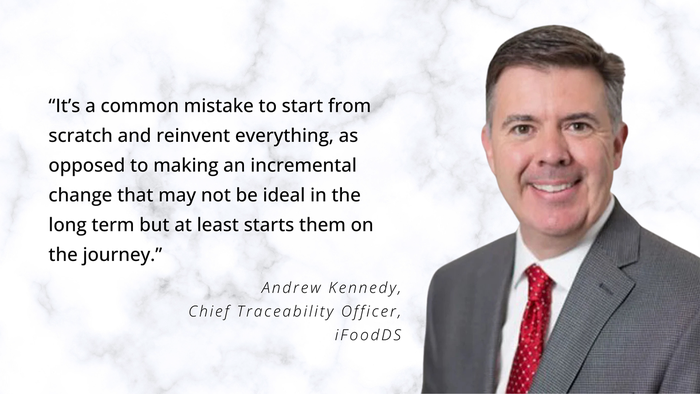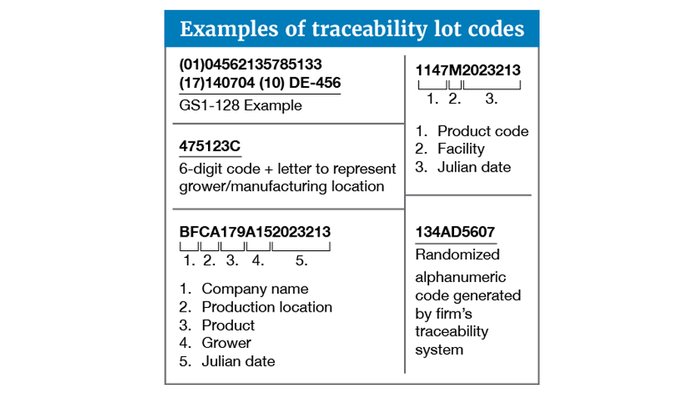How retailers can prepare for the FDA’s Food Traceability RuleHow retailers can prepare for the FDA’s Food Traceability Rule
Retailers are trying to navigate the complexities of the FDA’s Food Traceability Rule, FSMA 204 to meet a January 2026 compliance deadline. Learn more.
October 29, 2024

Already have an account?
At a Glance
- Food retailers must track high-risk foods, including nut butters and certain produce, to ensure quick recalls when needed.
- The extensive FSMA recordkeeping demands might require contracting with a third-party vendor.
- The deadline for meeting the FDA’s complex new Food Traceability Rule FSMA 204 is Jan. 20, 2026.
Like many retailers, Jacob Vincent, associate director of merchandising at Hanover Co-op Food Stores, is grappling with how section 204(d) of the FDA’s Food Safety Modernization Act (FSMA) will impact his company.
“We are still learning a lot about this,” says Vincent. who purchases from over 300 different vendors for the New Hampshire retailer. “We've attended a couple of webinars. It is overwhelming to think about.”&
Many in the industry feel the same way. With slightly more than year left until the Jan. 20, 2026, compliance deadline, time is running out for companies to figure things out.
The U.S. Food and Drug Administration’s Food Traceability Rule—commonly called “FMSA 204”—requires organizations that manufacture, process, pack or hold foods that are considered high-risk for “microbiological or chemical contamination” to increase their recordkeeping so potentially contaminated foods can be more quickly identified and removed. Companies have until Jan. 20, 2026, to comply.
Those foods—found on the FDA’s Food Traceability List (FTL)—include nut butters; many varieties of produce; certain aquatic species; ready-to-eat meatless deli salads; and numerous fresh, soft cheeses. The list is based on a matrix that looks at the risks associated with certain foods and food-borne pathogens like listeria, E.coli and salmonella, says Andrew Kennedy, a chief traceability officer at iFoodDS and a former FDA traceability expert who co-wrote the FSMA 204 Food Traceability Rule. Through the use of traceability lot codes and traceability lot source codes, regulators aim to increase the speed of recalls and conducting tracebacks more quickly in the hopes of having fewer foodborne illnesses and deaths.
“It’s a really big deal,” says Angela Bozo, director of member programs for the Independent Natural Food Retailers Association. “Especially in produce, where we can't get people to use the right PLU [price look-up code] to ring it through their register. Now we have to do these extra codes.” The rule affects all companies, both domestic and foreign, that produce food for U.S. consumption along the entire food supply chain: retailers, restaurants and farmers, anyone working with a company that does more than $250,000 in food sales annually.
“The problem so infrequently begins at the retail,” Bozo says. “A lot of the outbreaks and recalls we’ve seen over the past 20 years have started at manufacturers and farms.
“I understand the onus of wanting to understand where something came from,” she adds. “But the reality of the situation is that you would ultimately be getting that information from the retailer and then you're going to have to work your way backward.” That’s leaving many in the retail industry confused and frustrated. “A lot of the retailers that I’ve talked to are very shocked that the onus isn't more on manufacturers and farmers,” Bozo says.

What the FDA requires of retailers
The FDA will require organizations, including retailers, to provide an electronic sortable spreadsheet of traceability data within 24 hours of request if there is a foodborne illness outbreak or recall. Anyone in the food supply chain, from farmers to retailers, needs to maintain detailed records of what the FDA refers to as Key Data Elements (KDEs). This information, depending on where the food is in the supply chain, includes how the food was sourced, stored and modified. Key Data Elements must be tracked and provided to other businesses as a product moves along the supply chain. Records must be kept for at least two years.
Collected data may include the date when the food arrived, the freshness date, how it was stored, the temperature when it was shipped and more. These Critical Tracking Events happen as food moves through the supply chain from harvesting to shipping to receiving, with several points along the way.
Importance of Traceability Lot Codes and Traceability Lot Code Sources
Much of the data collection centers around using a Traceability Lot Code and Traceability Lot Code Source. Any ingredient or food that contains an ingredient on the Food Traceability List is assigned a Traceability Lot Code. Traceability Lot Codes are assigned when the food is initially packed, received by the first-land base receiver or transformed. These alpha-numeric descriptors uniquely identify food as it moves through the supply chain and can only be changed if the food is transformed.
Companies that use GS1 Standards typically use their GS1 Global Trade Item Numbers (GTINs) and an internal lot code to create their Traceability Lot Code. Companies also need to use a Traceability Lot Code Source which includes a location description, such as a physical address, of where the traceability code for the food was assigned. Alternatively, it might include a Traceability Lot Code Source Reference, which according to the FDA, which may link to an FDA Food Facility Registration Number for the traceability lot code source or a web address that provides FDA with the location description for the traceability lot code source.
“For each product that you produce, you need an identifier for lot code that you produce, which would tie it to a location, for a date, and then the product description, and then where was it produced,” Kennedy says.
Be able to package that information with your shipping information including ship from, ship to, ship date, the acquiring unit measure, and the purchase order or bill of lading (BOL) that you ship on, Kennedy says. “Package all that information together and be able to send it to the subsequent recipient,” he says. “On the flip side, that’s what you get for receiving.”
For transformation, when a product is received and converted into a finished product, it’s tracking the lot code in and the lot code out, Kennedy says.

The U.S. Food and Drug Administration created these examples of traceability lot codes.
The FDA hasn’t established a centralized database
While the FDA’s Food Traceability Rule requires companies to share information along the supply chain, regulators haven’t established a centralized database.
“My whole thing is if you want to do this, then don't you also want to run the database?” Bozo says. “That would make more sense to me if we were all feeding a centralized database that the FDA had access to.”
As a result, third-party vendors are filling the void. “The third-party piece is an opportunistic thing,” Vincent says. “They obviously want to help, but it's also an opportunity to make money. But honestly, it's going to be needed, right? I mean, who's going to work with the retailer, the packager, the wholesaler, the manufacturer and the grower? We certainly can't do that.”
Before seeking third-party vendors, many in retail are trying to train some of their internal team members on FMSA 204 to become more informed.
“GS1 has a really quick certification that can you get you educated on traceability in 16 hours,” Bozo says. “I had two members of my staff do the training to get that baseline knowledge.”
For now, Vincent is putting together an internal team that can focus on what needs to be done for FSMA 204. The group includes an executive team member, a liaison between the retailer and the vendors, a receiving team manager, the IT team and more. “We know we’re going to have to automate this record keeping somehow,” Vincent says. He wants that internal team to understand the high-level requirements and come up with a plan to work with everyone from vendors to the store’s commercial kitchen staff.
One of the biggest pieces is figuring out to how automate processes and procedures. “That's really key in the retail industry right now,” he says. “Automation is so important because we don't have the manpower that we used to have.”
Vincent expects his IT team will research third-party vendors and find out what might integrate within its current, ECRS point-of-sales system. “I don’t see how we could do it without a third-party vendor,” he says.
Creating relationships key to the program
“It affects everyone along the supply chain,” Vincent says. “Every step of the industry needs to be able to be able to work together and that doesn't happen.”
“And who's going to regulate that?” he adds. “It’s going to have to fall on third parties taking advantage of the situation to be able to develop products that allow things to be tracked through the systems through all these different events.”
When working with a third-party vendor, don’t look to overhaul the entire system, says Kyle Svete, senior director of sales at iFoodDS. Instead, look at existing systems that are already in place and see what they can handle. IFoodDS subsidiary New Era Partners helps enterprises navigate the complexities of the FDA’s Food Traceability Rule, FSMA 204.
Create a single point of entry, Kennedy says. “If you have to do something twice, you’re probably not going to do it,” he says. “If you are capturing traceability information for a shipment to a customer that is tied to an invoice and you’re going to get paid for it, you’re going to do that.” But if you have to open another application, scan something or do something else to create that traceability record, you’re probably going to stop doing it after a while, because that’s extra work and there’s no direct financial impact to you.
“If the financial transaction and the regulatory transaction are captured at the same time with the same software, with the same application, that will get done every single time,” says Kennedy, the former FDA traceability expert. “So single point of entry is really the key.”
Companies should also test what they are currently doing now and identify what they are missing, Kennedy says. Too many companies immediately jump and want to try five new things but have no idea if what they were already doing was already working in some fashion.
“It’s a common mistake to start from scratch and reinvent everything, as opposed to making an incremental change that may not be ideal in the long term but at least starts them on the journey.”
About the Author
You May Also Like





